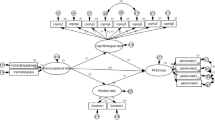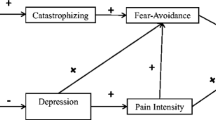Abstract
Anxiety sensitivity (AS) is the fear of anxiety-related bodily sensations, arising from beliefs that the sensations have harmful consequences. There has been a good deal of research on the role of AS in anxiety disorders, and only recently have investigators begun to assess its role in other conditions. In a preliminary report, Asmundson and Norton (1995) found that chronic back-pain patients with high AS (n=14), compared to those with lower AS (n=56), reported greater pain-related fear, and tended to have greater avoidance. The present study further investigated the role of AS in pain-related fear and escape/avoidance. Patients with chronic musculoskeletal pain (N=259) completed measures of AS, pain severity, and pain-related fear and escape/avoidance. Structural equation modeling supported the prediction that AS directly exacerbates fear of pain, even after controlling for the effects of pain severity on fear of pain. Support also was found for the prediction that AS indirectly promotes pain-related escape/avoidance via its influence on fear of pain. This indirect effect was significant even when controlling for the direct influence of pain severity on pain-related escape/avoidance. These results suggest that AS plays an important role in pain-related fear and escape/avoidance in people with chronic pain.
Similar content being viewed by others
References
Asmundson, G. J. G., and Norton, G. R. (1995). Anxiety sensitivity in patients with physically unexplained chronic back pain: A Preliminary report.Behav. Res. Ther., 33: 771–777.
Bollen, K. A. (1989).Structural Equations with Latent Variables, Wiley, New York.
Craske, M. G., and Barlow, D. H. (1989).Therapist's Guide for the Mastery of Your Anxiety and Panic (MAP) Program, Graywind, New York.
Fordyce, W. E., Shelton, J. L., and Dundore, D. (1982). The modification of avoidance learning in pain behaviors.J. Behav. Med. 5: 405–414.
Gorsuch, R. (1983).Factor Analysis, Erlbaum, Hillsdale, NJ.
International Association for the Study of Pain (1986). Classification of chronic pain.Pain (Suppl. 3): S1-S226.
Marsh, H. W., Balla, J. R., and McDonald, R. P. (1988). Goodness-of-fit indexes in confirmatory factor analysis: The effect of sample size.Psychol. Bull. 103: 391–410.
McCracken, L. M., Zayfert, C. and Gross, R. T. (1992). The Pain Anxiety Symptoms Scale: Development and validation of a scale to measure fear of pain.Pain 50: 67–73.
McCracken, L. M., Gross, R. T., Sorg, P. J., and Edmands, T. A. (1993a). Prediction of pain in patients with chronic low back pain: Effects of inaccurate predictions and pain-related anxiety.Behav. Res. Ther. 31: 647–652.
McCracken, L. M., Zayfert, C., and Gross, R. T. (1993b). The Pain Anxiety Symptoms Scale (PASS): A multi-modal measure of pain-specific anxiety symptoms.Behav. Ther. 16: 183–184.
McDonald, R. P. (1985).Factor Analysis and Related Methods, Erlbaum, Hillsdale, NJ.
Melzack, R. (1987). The short-form McGill Pain Questionnaire.Pain 30: 191–197.
Peterson, R. A., and Reiss, S. (1992).Anxiety Sensitivity Index Manual (2nd ed.), International Diagnostic Systems, Worthington, OH.
Philips, H. C. (1987). Avoidance behaviour and its role in sustaining chronic pain.Behav. Res. Ther. 25: 273–279.
Rachman, S., and Arntz, A. (1991). The overprediction and underprediction of pain.Clin. Psychol. Rev. 11: 339–355.
Reiss, S. (1991). Expectancy theory of fear, anxiety, and pain.Clin. Psychol. Rev., 11: 141–153.
Reiss, S., and McNally, R. J. (1985). The expectancy model of fear. In Reiss, S., and Bootzin, R. R. (eds.),Theoretical Issues in Behavior Therapy, Academic, New York, pp. 107–121.
Steiger, J. H. (1989).EzPATH [computer program], SYSTAT, Inc., Evanston, IL.
Tabachnick, B. G., and Fidell, L. S. (1989).Using Multivariate Statistics (2nd ed.), Harper & Row, New York.
Taylor, S. (1995). Anxiety sensitivity: Theoretical perspectives and recent findings.Behav. Res. Ther. 33: 243–258.
Taylor, S., Koch, W. J., Woody, S., and McLean, P. (1996). Anxiety sensitivity and depression: How are they related?J. Abnorm. Psychol. 105: 474–479.
Tucker, L. R., and Lewis, C. (1973). A reliability coefficient for maximum likelihood factor analysis.Psychometrika 25: 1–10.
Vlaeyen, J. W. S., Kole-Snijders, A. M. J., Boeren, R. G. B., and van Eek, H. (1995). Fear of movement/(re)injury in chronic low back pain and its relation to behavioural performance.Pain 62: 363–372.
Waddell, G. (1987). A new clinical model for the treatment of low back pain.Spine 9: 204–208.
Waddell, G., Newton, M., Henderson, I., Sommerville, D., and Main, C. J. (1993). A fear-avoidance beliefs questionnaire (FABQ) and the role of fear-avoidance beliefs in chronic low back pain and disability.Pain 52: 157–168.
Author information
Authors and Affiliations
Rights and permissions
About this article
Cite this article
Asmundson, G.J.G., Taylor, S. Role of anxiety sensitivity in pain-related fear and avoidance. J Behav Med 19, 577–586 (1996). https://doi.org/10.1007/BF01904905
Accepted:
Issue Date:
DOI: https://doi.org/10.1007/BF01904905




